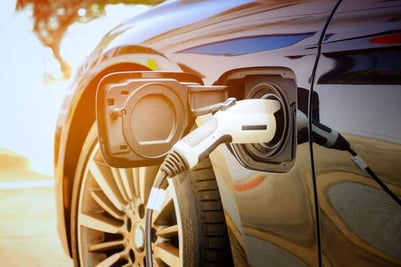Electric vehicles have become common place in today’s transportation, from personal cars and small trucks to mass transit. As technology is evolving in electric mobile vehicles, major OEMs of construction, off-highway and warehousing equipment are pursuing a combination of full electric and electric hybrid equipment in response to the ecological demand to reduce fuel costs, lower carbon footprints and comply with increasingly stringent emissions directives. These OEMs, drive-train manufacturers, and other technology companies are developing methods to use battery-powered electric drives and hybrid electric/diesel drives for off-highway vehicles and to power excavator arms, dump truck beds, and other attachments. One of the primary areas of R&D for electrification in construction and agricultural equipment that use diesel engines for their drive-trains and hydraulics is the 700-Volt machine class.
These OEMs, drive-train manufacturers, and other technology companies are developing methods to use battery-powered electric drives and hybrid electric/diesel drives for off-highway vehicles and to power excavator arms, dump truck beds, and other attachments. One of the primary areas of R&D for electrification in construction and agricultural equipment that use diesel engines for their drive-trains and hydraulics is the 700-Volt machine class.
In addition, research and prototyping is being conducted to explore the elimination of redundant bearings and seals, and significantly reduce inefficiencies in vehicle components. This research is pointing toward hybrid designs that allow for hydraulic fluid to cool electric machines and drive the electronics, allowing for high electric loading capacities. This could deliver the benefits of low inertia, high electric-hydraulic energy efficiency and high power density. One of the major endeavors of this research is to develop a hydraulic actuator for a 20-ton excavator.
The development of electronics in heavy equipment does not mean a complete replacement of hydraulics. Instead, the industry is working to find ways to incorporate electronics in off-highway equipment for increasing efficiencies and maximizing the effectiveness of hydraulic technology.
Digital Displacement Pumps and Other Technologies for Electronic Control Precision in Hydraulics
By replacing a standard pump with a digitally enabled pump, Danfoss’s Digital Displacement® Hydraulics provides better fuel consumption along with improved productivity and control, and has the potential to downsize battery packs or even engines. This technology has the capability to achieve:
- Smoother, faster control to accomplish more work per hour
- Increased maximum power for improved engine-to-work efficiency with the same size engine
- The opportunity to downsize engines without loss of control or power
- Intelligent digital controls to activate individual cylinders only when required
This results in smaller batteries and longer work-cycles for next-generation electric equipment.
Limitations of Electrification versus Traditional Hydraulics
As referred to above, mobile equipment manufacturers are hotly pursuing electrification in heavy equipment. The idea of replacing diesel engines and traditional hydraulics with electric drives and batteries in heavy equipment seems almost science fiction. And realistically OEMs have to balance the financial and engineering implications before “throwing out the proverbial hydraulic components with the fluid”.
According to Thomas Schulze, Drive System Application Engineer at Liebherr Components in Biberach, Germany; “The power density of hydraulics in most applications can’t be matched by electric drives at present. That’s because it is so much greater and the cost benefit is the main factor for a lot of applications,” However, increasing pressure from government regulations are demanding equipment redesign to reduce emissions, making it necessary for OEMs to have a strategy for electrification.
Though one of the predictable issues with electrification in mobile machines is how to incorporate enough batteries to supply ample power for operating a machine for the time it would take to satisfy the application. Schulze further states; “There will be some mobile applications in which batteries make sense. But when applications require a lot of power and extensive driving, a diesel-electric unit is essential.” Beyond engineering all the required battery power and space to fit it, it also comes down to costs; “An installed kilowatt-hour costs around $600 and if a machine requires 70 to 80 kWh, you have up to $48,000 of investment costs only for a battery. It won’t work. So the main focus of electrification will be for sites and cities that mandate local zero emissions. Then we have to do it, despite the fact that today, in most cases, there is no cost benefit”.
As noted above, and Schulze emphasizes; “…not only is a battery necessary for electrification. Another requirement is an electric motor with the same torque and size as a hydraulic motor. A standard electric motor would be much larger, and you just don’t have the available space in a mobile machine.”
“For Liebherr, the solution is high-speed electric motors. A normal electric motor may run at 1,500 up to 4,500 rpm. But if it could operate at 14,000 or 20,000 rpm, the motor gets smaller and lighter. It becomes possible to use a more compact motor design for the same drive performance,” he said. “But then you have the problem of the 14,000 rpm input to a gearbox that normally has a maximum limit of 3,000 to 4,000 rpm.” That being said, Liebherr is working on a solution with a high-speed planetary gearbox stage specially optimized to cool and lubricate. The gearbox technology integrates into the motor and reduces output speed enabling it to connect directly to standard drive-train components.
To achieve complete electrification it comes down to when there will be advancements in battery technology with regard to weight, size and cost. The future may be near, but it’s not quite here.
Additional sources include:
• Hydraulics & Pneumatics
• Design of a Highly Integrated Electric-Hydraulic
